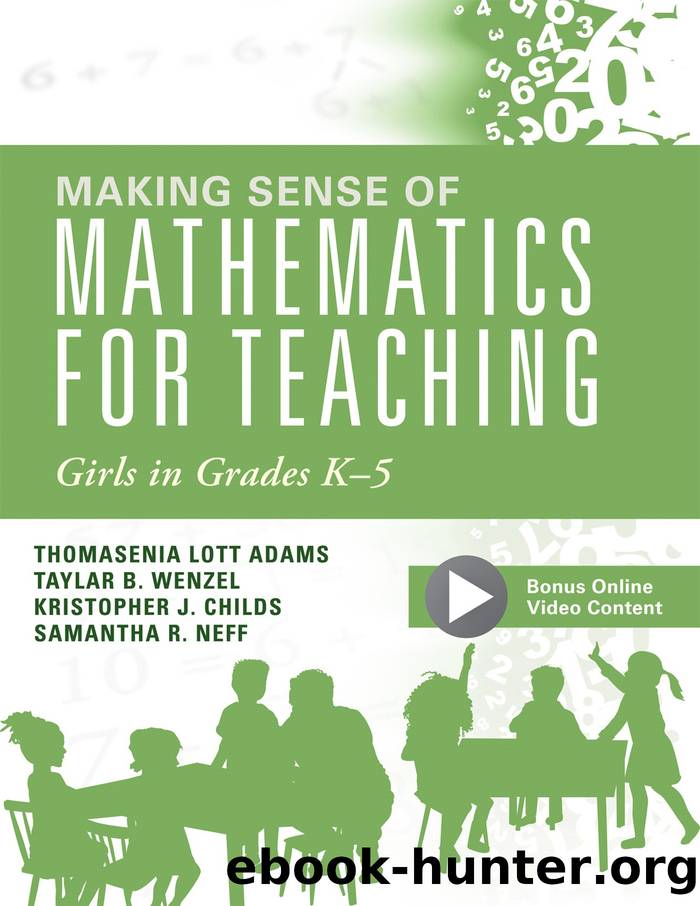Making Sense of Mathematics for Teaching Girls in Grades K - 5 by Adams Thomasenia Lott;Wenzel Taylar B.;Childs Kristopher J.;Neff Samantha R.;

Author:Adams, Thomasenia Lott;Wenzel, Taylar B.;Childs, Kristopher J.;Neff, Samantha R.;
Language: eng
Format: epub
Publisher: Solution Tree
Published: 2019-08-15T00:00:00+00:00
Interpreting the Remainder in Word Problems:
www.SolutionTree.com/Interpreting_the_Remainder_in_Word_Problems
Now that you had the opportunity to observe a fourth-grade lesson where students have an opportunity to write their own word problems, consider how the teacher carefully uses the role of context in task selection and lesson facilitation. We now provide additional insight via our reactions to the guiding questions.
What Actions Does the Teacher Take to Engage the Girls in Learning Mathematics?
In this lesson, the teacher plans a task in which students create their own word problems to interpret the remainder. As the teacher introduces the task, it becomes evident that many students struggle to write a word problem in which the context matches the mathematics in the problem. It seems evident that the teacher anticipates that students may struggle to make sense of the task initially as she offers follow-up questions to help the students make sense of the task and consider what types of contexts might fit the task as it is presented. Her responses include the following.
â âYou canât find a number that you multiply by 4 to get 26? So, what does that mean?â
â âBut I challenged you to come up with a word problem where the answer would be seven ⦠thatâs pretty tough. Talk about that at your tables.â
â âSo, whatâs your question going to be?â
â âBut, what was our goal for this task?â
Students are creating word problems to understand the mathematics. By allowing students to create their own contexts for the mathematics presented, students can select a context that is relevant to them while also making sense of the mathematics.
Download
This site does not store any files on its server. We only index and link to content provided by other sites. Please contact the content providers to delete copyright contents if any and email us, we'll remove relevant links or contents immediately.
Macmillan Primary Grammar 2 Pupil's Book by Unknown(387)
Figuring Out Fluency in Mathematics Teaching and Learning, Grades K-8 by Jennifer M. Bay-Williams & John J. SanGiovanni(350)
The Principal's Guide to Curriculum Leadership by Sorenson Richard D.;Goldsmith Lloyd M.;Mendez Zulma Y.;Maxwell Karen T.;(277)
English Grammar Practice--The Noun by Roxana Nastase(238)
Learning from Accidents 3rd ed by Trevor Kletz (2001)(234)
Harnessing Technology for Deeper Learning by Scott McLeod(225)
Text-Dependent Questions, Grades K-5 by Douglas Fisher & Nancy Frey & Heather Anderson & Marisol Thayre(214)
A Guide to Curriculum Mapping by Hale Janet A.;(208)
English Language Program Administration by Unknown(204)
Deep Change Leadership by Reeves Douglas;(195)
How to Do Everything with Google Tools by Unknown(194)
The Grammar Teacher's Activity-a-Day by Jack Umstatter(184)
The Power of SMART Goals by Conzemius Anne;O'Neill Jan; & Anne Conzemius(182)
Beyond the RTI Pyramid by Bender William N.;(162)
Aligning and Balancing the Standards-Based Curriculum by Squires David A.;(159)
Using Data to Close the Achievement Gap by Johnson Ruth S.;(157)
Using Equity Audits to Create Equitable and Excellent Schools by Skrla Linda E.;McKenzie Kathryn B.;Scheurich James Joseph;(153)
Differentiated Instructional Strategies for the Block Schedule by Gregory Gayle H.;Herndon Lynne E.; & Lynne E. Herndon(152)
You've Got to Reach Them to Teach Them by Schreck Mary Kim; & Schreck(142)
